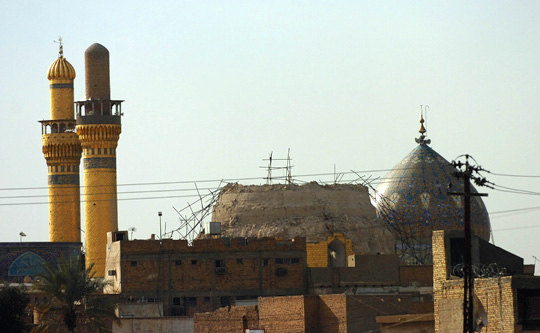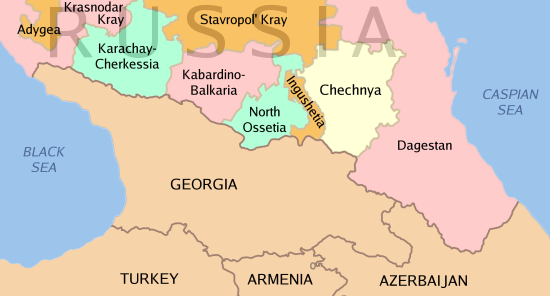|
Caucasus Emirate
The Caucasus Emirate (, IK; ), also known as the Caucasian Emirate, Emirate of Caucasus, or Islamic Emirate of the Caucasus, was a jihadist organisation active in rebel-held parts of Syria and previously in the North Caucasus region of Russia. Its intention was to expel the Russian presence from the North Caucasus and to establish an independent Islamic emirate in the region. The ''Caucasus Emirate'' also referred to the state that the group sought to establish. The creation of Caucasus Emirate was announced on 7 October 2007, by Chechen warlord Dokka Umarov, who became its first self-declared "emir"."Two years of Imarat Kavkaz: jihad spreads over Russia's south" , ''Caucasian Knot'', 7 October 2009. By late 2015, the group no longer had a visible presence in the North Caucasus ... [...More Info...] [...Related Items...] OR: [Wikipedia] [Google] [Baidu] [Amazon] |
Caucasian Front (militant Group)
The Caucasian Front (), also known as Caucasus Front or the Caucasian Mujahideen, established in May 2005 as an Islamic structural unit of the Chechen Republic of Ichkeria's armed forces by the decree of the fourth president of the Chechen Republic of Ichkeria, Abdul-Halim Sadulayev. In September 2006, Ali Taziev was appointed as the emir and commander-in-chief of the Caucasian Front by Dokka Umarov. The group eventually reorganized as " Vilayat Nokhchicho" in 2007 and became a part of the Caucasus Emirate. History The group united various rebel Jamaat groups across the North Caucasus, including the Ingush Jamaat, Shariat Jamaat, Yarmuk Jamaat and Kataib al-Khoul, to fight the Russian rule not only in Chechnya but also in the rest of the Caucasus. It was led by a Chechen commander Shamil Basayev until his death in July 2006 and since then by Ali Taziev. In October 2007 the Caucasian Front later became the Caucasus Emirate, a self proclaimed emirate. While the ant ... [...More Info...] [...Related Items...] OR: [Wikipedia] [Google] [Baidu] [Amazon] |
Flag Of Jihad
The jihadist flag is a flag commonly used by various Islamist and Islamic fundamentalist movements as a symbol of jihad. It usually consists of the Black Standard with a white text of the ''Shahada'' (Islamic declaration of faith) emblazoned across it in Arabic calligraphy. Its usage is asserted to be adopted by Islamist groups and jihadists during the 1990s and early 2000s. Organizations who use jihadist flags include al-Qaeda, al-Shabaab, the Taliban, Palestinian Islamic Jihad, the al-Qassam Brigades and Jemaah Islamiyah. ''Muqwaki'' seal variant The variant used by the Islamic State, al-Qaeda in the Arabian Peninsula, al-Qaeda in the Islamic Maghreb, Islamic State of Iraq, and al-Shabaab depicts the '' Muqwaki'' variant of the alleged seal of Muhammad, which some scholars consider to be an anachronistic forgery. Legality In August 2014, British Prime Minister David Cameron suggested that anybody displaying "the Islamic State flag" in the United Kingdom should be arr ... [...More Info...] [...Related Items...] OR: [Wikipedia] [Google] [Baidu] [Amazon] |
Islamic State
The Islamic State (IS), also known as the Islamic State of Iraq and the Levant (ISIL), the Islamic State of Iraq and Syria (ISIS) and Daesh, is a transnational Salafi jihadism, Salafi jihadist organization and unrecognized quasi-state. IS occupied significant territory in Iraq and Syria in 2013, but lost most of it in 2019. In 2014, the group proclaimed itself to be a worldwide caliphate, and claimed religious, political, and military authority over all Muslims worldwide, a claim not accepted by the vast majority of Muslims. It is List of designated terrorist groups, designated as a terrorist organisation by the United Nations and many countries around the world, including Muslim world, Muslim countries. By the end of 2015, its self-declared caliphate ruled an area with a population of about 12 million, where they enforced their extremist interpretation of Islamic law, managed an annual budget exceeding billion, and commanded more than 30,000 fighters. After a grinding co ... [...More Info...] [...Related Items...] OR: [Wikipedia] [Google] [Baidu] [Amazon] |
Emir
Emir (; ' (), also Romanization of Arabic, transliterated as amir, is a word of Arabic language, Arabic origin that can refer to a male monarch, aristocratic, aristocrat, holder of high-ranking military or political office, or other person possessing actual or ceremonial authority. The title has a history of use in West Asia, East Africa, West Africa, Central Asia, and South Asia. In the modern era, when used as a formal monarchical title, it is roughly synonymous with "prince", applicable both to a son of a hereditary monarch, and to a reigning monarch of a sovereign principality, namely an emirate. The female, feminine form is emira ( '), with the same meaning as "princess". Prior to its use as a monarchical title, the term "emir" was historically used to denote a "commander", "general", or "leader" (for example, Amir al-Mu'min). In contemporary usage, "emir" is also sometimes used as either an honorary or formal title for the head of an Islamic, or Arab (regardless of relig ... [...More Info...] [...Related Items...] OR: [Wikipedia] [Google] [Baidu] [Amazon] |
Islamic Emirate
An emirate is a territory ruled by an emir, a title used by monarchs or high officeholders in the Muslim world. From a historical point of view, an emirate is a political-religious unit smaller than a caliphate. It can be considered equivalent to a principality in non-Muslim contexts. Currently in the world, there are two emirates that are independent states (Kuwait and Qatar), one state ruled by an unrecognised emirate (Afghanistan), and a state that consists of a federation of seven emirates (the United Arab Emirates). A great number of previously independent emirates around the world are now part of larger states. Etymology Etymologically, emirate or amirate ( ' plural: ' is the quality, dignity, office, or territorial competence of any emir (prince, commander, governor, etc.). In English, the term is pronounced or in British English and or in American English. Types Monarchies The United Arab Emirates is a federal state that comprises seven federal emirates, each adm ... [...More Info...] [...Related Items...] OR: [Wikipedia] [Google] [Baidu] [Amazon] |
Russia
Russia, or the Russian Federation, is a country spanning Eastern Europe and North Asia. It is the list of countries and dependencies by area, largest country in the world, and extends across Time in Russia, eleven time zones, sharing Borders of Russia, land borders with fourteen countries. Russia is the List of European countries by population, most populous country in Europe and the List of countries and dependencies by population, ninth-most populous country in the world. It is a Urbanization by sovereign state, highly urbanised country, with sixteen of its urban areas having more than 1 million inhabitants. Moscow, the List of metropolitan areas in Europe, most populous metropolitan area in Europe, is the capital and List of cities and towns in Russia by population, largest city of Russia, while Saint Petersburg is its second-largest city and Society and culture in Saint Petersburg, cultural centre. Human settlement on the territory of modern Russia dates back to the ... [...More Info...] [...Related Items...] OR: [Wikipedia] [Google] [Baidu] [Amazon] |
Syria
Syria, officially the Syrian Arab Republic, is a country in West Asia located in the Eastern Mediterranean and the Levant. It borders the Mediterranean Sea to the west, Turkey to Syria–Turkey border, the north, Iraq to Iraq–Syria border, the east and southeast, Jordan to Jordan–Syria border, the south, and Israel and Lebanon to Lebanon–Syria border, the southwest. It is a republic under Syrian transitional government, a transitional government and comprises Governorates of Syria, 14 governorates. Damascus is the capital and largest city. With a population of 25 million across an area of , it is the List of countries and dependencies by population, 57th-most populous and List of countries and dependencies by area, 87th-largest country. The name "Syria" historically referred to a Syria (region), wider region. The modern state encompasses the sites of several ancient kingdoms and empires, including the Eblan civilization. Damascus was the seat of the Umayyad Caliphate and ... [...More Info...] [...Related Items...] OR: [Wikipedia] [Google] [Baidu] [Amazon] |
Jihadist
Jihadism is a neologism for modern, armed militant Political aspects of Islam, Islamic movements that seek to Islamic state, establish states based on Islamic principles. In a narrower sense, it refers to the belief that armed confrontation is an efficient and theologically legitimate method of socio-political change towards an Islamic governance, Islamic system of governance. The term "jihadism" has been applied to various Islamic extremism, Islamic extremist or Islamism, Islamist individuals and organizations with militant ideologies based on the classical Islamic notion of ''Jihad, lesser jihad''. Jihadism has its roots in the late 19th- and early 20th-century ideological developments of Islamic revivalism, which further developed into Qutbism and Salafi jihadism related ideologies during the 20th and 21st centuries. Jihadist ideologues envision ''jihad'' as a "revolutionary struggle" against the international order to unite the Muslim world under Islamic law. The Islam ... [...More Info...] [...Related Items...] OR: [Wikipedia] [Google] [Baidu] [Amazon] |
Flag Of Caucasian Emirate
A flag is a piece of fabric (most often rectangular) with distinctive colours and design. It is used as a symbol, a signalling device, or for decoration. The term ''flag'' is also used to refer to the graphic design employed, and flags have evolved into a general tool for rudimentary signalling and identification, especially in environments where communication is challenging (such as the maritime environment, where semaphore is used). Many flags fall into groups of similar designs called flag families. The study of flags is known as "vexillology" from the Latin , meaning "flag" or "banner". National flags are patriotic symbols with widely varied interpretations that often include strong military associations because of their original and ongoing use for that purpose. Flags are also used in messaging, advertising, or for decorative purposes. Some military units are called "flags" after their use of flags. A ''flag'' (Arabic: ) is equivalent to a brigade in Arab countries. In ... [...More Info...] [...Related Items...] OR: [Wikipedia] [Google] [Baidu] [Amazon] |
Second Chechen War
Names The Second Chechen War is also known as the Second Chechen Campaign () or the Second Russian Invasion of Chechnya from the Chechens, Chechen insurgents' point of view.Федеральный закон № 5-ФЗ от 12 января 1995 (в редакции от 27 ноября 2002) "О ветеранах" Historical basis of the conflict Russian Empire Chechnya is an area in the North Caucasus, Northern Caucasus which has constantly fought against foreign rule, including the Ottoman Turks in the 15th century. The Russian Terek Cossacks, Terek Cossack Host was established in lowland Chechnya in 1577 by free Cossacks who were resettled from the Volga to the Terek River. In 1783, the Russian Empire and the Georgia (country), Georgian Kingdom of Kartli-Kakheti signed the Treaty of Georgievsk, under which Kartli-Kakheti became a Russian protectorate. To secure communications with Georgia (country), Georgia and other regions of the Transcaucasia, the Russian Empire ... [...More Info...] [...Related Items...] OR: [Wikipedia] [Google] [Baidu] [Amazon] |
Russo-Caucasian Conflict
The Russo-Caucasian conflict is a protracted ethnic and political struggle between various Ethnic groups in the Caucasus, North Caucasian peoples and Russians, Russian, Soviet Union, Soviet, and Russian Empire, Imperial Russian authorities. This conflict dates back to the 16th century, as Russian forces sought to expand southward. Various Caucasian groups, including Abazins, Abkhazians, Circassians, Chechens, Ingush people, Ingush, Karachays, KarachayBalkars, -Balkars, Ossetians and Dagestanis (various Dagestani nations), resisted Russian control through both armed and diplomatic means. The conflict’s modern phase intensified following the Dissolution of the Soviet Union, Soviet Union’s collapse in 1991, with separatist aspirations and resistance movements that continued to face suppression into the 21st century. Background Geopolitical Significance The Caucasus, Caucasus region, bridging Europe and Asia, holds immense geopolitical importance. Its strategic location between ... [...More Info...] [...Related Items...] OR: [Wikipedia] [Google] [Baidu] [Amazon] |





